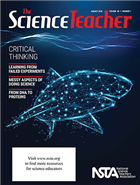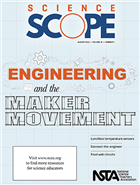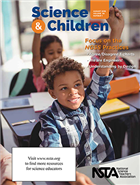Ideas and inspiration from NSTA’s August 2018 K-12 journals
By Mary Bigelow
Posted on 2018-08-15
The August issues are ready for back-to-school! Regardless of what grade level or subject you teach, as you skim through the article titles, you may find ideas for lessons that would be interesting your students or the inspiration to adapt/create/share your own.
NSTA members, as always, have access to the articles in all journals! Click on the links to read or add to your library.
 The Science Teacher – Critical Thinking
The Science Teacher – Critical Thinking
Editor’s Corner: It’s Critical: Science teachers are uniquely positioned to affirm the importance of critical thinking. Although teaching it is challenging, it is our moral imperative as educators to help students learn to think and to reason, to evaluate claims using evidence and sound logic.
The lessons described in the articles include a chart showing connections with the NGSS. The graphics are especially helpful in understanding the activities and in providing ideas for your own investigations.
Some teachers may be concerned about investigations and activities because students might not get successful results. The author of Learning From Failed Experiments intentionally allowed student errors and provided guidance in making sense of “mistakes.”
- Data-Driven Inquiry in the PBL Classroom illustrates how students can explore data in maps, graphs, and tables in Biology problem-based learning. The context is a study of marine predators.
- While learning facts and concepts is important, From DNA to Proteins shows how students can combine PBL and argumentation in a comparison of normal and sickle-cell hemoglobin.
- The activities and processes in Making Science Relevant involves connecting science concepts and processes with social issues (e.g., fracking, climate change, gene editing). The article includes a graphic with suggestions for helping students evaluate sources of information.
- Could Your Food Be Contaminated? would be an intriguing and relevant question question for students to explore and investigate how mycotoxins affects crops, animals, and consumers.
- Focus on Physics: Care in the Classroom: This Teacher’s Odyssey is a teachers’ reflection on interacting with students, designing meaningful “exams,” and sharing the joy of learning.
These monthly columns continue to provide background knowledge and classroom ideas:
For more on the content that provides a context for projects and strategies described in this issue, see the SciLinks topics Careers in Earth Science, Climate Change, DNA Structure and Function, Forces and Motion, Food Crops, Fungi, Genetic Engineering, Mutations, Newton’s Laws of Motion, Newton’s Second Law, Sickle Cell Anemia, Transcription, Translation, Volcanoes
Continue to Science Scope and Science and Children…
 Science Scope – Engineering and the Maker Environment
Science Scope – Engineering and the Maker Environment
From the Editor’s Desk: Reinventing STEM Through the Maker Movement: A maker is a creator who loves to experiment and who isn’t put off by failure. Whether it is wielding a seam ripper for the purpose of resewing an errant seam, tweaking a 3-D–printed design, or rerunning lines of code, a maker attitude is essential. The drive to create propels makers to overcome challenges by exploring, innovating, and problem solving—the same skills that scientists and engineers use—and the same skills we hope to foster within our students.
Articles in this issue that describe lessons (many of which use the 5E model) include a helpful sidebar documenting the big idea, essential pre-knowledge, time, safety issues, and cost. The lessons also include connections with the NGSS.
- The investigations in Inspiring Student-Driven Observations involve students using temperature sensors to monitor small changes in temperature that can affect the overall climate.
- Build a better lumchbox! The Temperature-Sensing Lunchbox incorporates knowledge of thermal energy transfer with sewing and coding experience in a practical project.
- The lesson in Connect-the-Engineer Activity could be an introduction to types of engineering and the design process.
- Spark up your lesson on food webs with the ideas in Illuminating Food Webs. Students integrate concepts in life science with electronic circuits to create illustrated food webs.
- Making in the Middle: Celebrity Statues describes an afterschool activity that integrates life science and engineering as students develop skills in design and programming.
- Looking for a variation on science fairs? Commentary: A Real-World STEM Competition has information on the eCYBERMISSION project, a way of encouraging students to address community problems through the application of science and engineering methods.
- Disequilibrium: Flight and the Bernoulli Effect includes a 5E lesson to incoporate learning about forces and motion with paper airplanes, soda cans, balloons, and straws.
These monthly columns continue to provide background knowledge and classroom ideas:
- Scope on the Skies: Return to Sender (part 2) focuses on asteroids.
- Interdisciplinary Ideas: Creating a Classroom Library has suggestions for managing a library, too.
- Teacher To Teacher: Forming Parent-Teacher Relationships Around Three-Dimensional Learning includes a template for communicating with parents.
- Citizen Science: Be a Zombee Hunter for Science involves students in tracking honeybees and their parasites.
- Science For All: Engineering a Classroom That Works for All suggests classroom management tips for students with learning differences (routines, instructions, organization)
For more on the content that provides a context for projects and strategies described in this issue, see the SciLinks topics Asteroids, Bernoulli’s Principle, Biomes, Changes in Climate, Conservation of Energy, Engineer, Food Webs, Forces of Flight, Honeybees, Insulation, Robots, Telescopes, Temperature and Heat, Thermal Energy, Weather and Climate

Science & Children – Focus on the NGSS Practices
Editor’s Note: Planting and Practicing: We can learn from each other, whether down the hallway or across the globe. The journal serves as a way to widen our common collaboration pathways both vertically and horizontally.
The lessons described in the articles have a chart showing connections with the NGSS. Many are based on the 5E (or 7E) model and include classroom materials, illustrations of student work, and photographs of students engaged in the activities.
- Guest Editorial: Addressing Common Questions About 21st-Century Science Teaching sets the stage for the theme of this issue. The author includes a chart of NGSS Science and Engineering Practices and what these would look like in a primary classroom. She also addresses questions about inquiry, skills, habits of mind, and the “scientific method.”
- With musical instruments as a context, Waves Sound Great! shows how students can make connections between real-life and science concepts/practices. The activities include hands-on, technology, and investigations.
- T-charts as a way to organize or summarize information have been around for a while. Agree/Disagree T-charts illustrates how this tool can support student argumentation and modeling. (The photos of the second graders’ models are especially interesting.)
- Start with the end in mind is the basis of the Understanding by Design model. This article describes how this process is useful when designing instructional activities to support NGSS standards. The activity in the article focused on investigating the strength of glue in building things.
- As the authors state, children are naturals at building things. Along with their imaginations and creativity, they can say We Are Engineers! In these activities, they are building bridges, towers, catapults, and boats.
- “Children’s use of the [NGSS] practices is based on prior experiences.” The Early Years: Making Sense of Their World includes a lesson on looking for patterns in the movement of the sun.
- In addition to recommending trade books, Teaching Through Trade Books: Important Impacts has lessons on Becoming Gardeners (K-2) and Repurposing Plastics (3-5).
- Teaching Teachers: The Language of Science in the Reading and Writing of Student Scientists illustrates different genres of science writing.
- Engineering Encounters: How Can We Store Water During a Drought? addresses a real-life question as students investigate water use and sustainability.
- Methods and Strategies: Seeds of Practice discusses how to modify a lesson using the 5E model to incorporate Science and Engineering Practices.
These monthly columns continue to provide background knowledge and classroom ideas:
For more on the content that provides a context for projects and strategies described in this issue, see the SciLinks topics Density, Erosion, How Can Matter Be Measured and Compared, Physical Properties of Matter, Plant Growth, Plants with Seeds, Recycling, Sound, Sun, Water Cycle, Watersheds, Writing for Science
Disclaimer: The views expressed in this blog post are those of the author(s) and do not necessarily reflect the official position of the National Science Teaching Association (NSTA).


